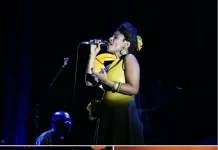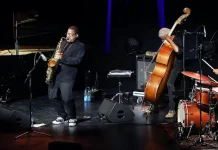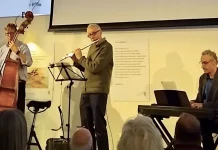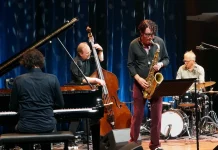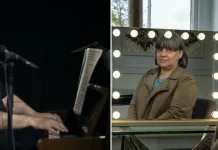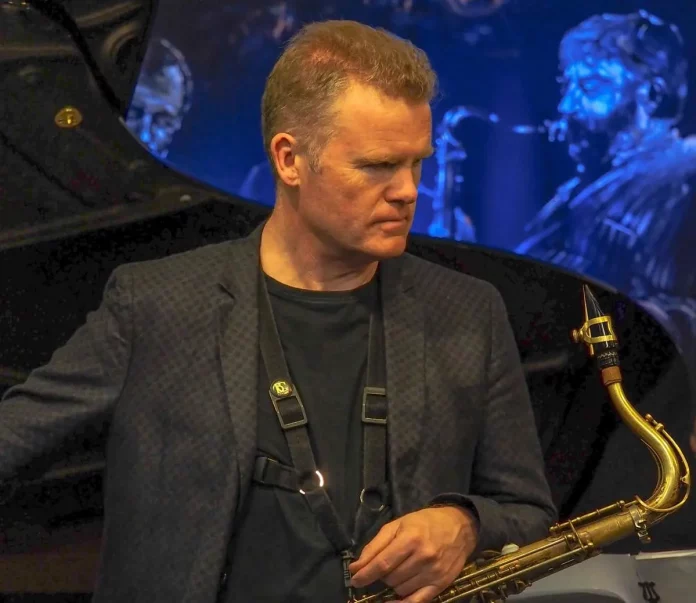
Iain Ballamy might be the first to admit that you don’t have to be a jazz musician to play the solo part in a saxophone concerto any more than a jazz band rather than a symphony orchestra might be required to perform Darius Milhaud’s La Création Du Monde with conviction.
Ballamy, however, was the inspiration for and the dedicatee of Tracks In The Orbit, the new concerto for tenor saxophone and orchestra by the UK-Australian composer Luke Styles. It was given its world première in Cardiff by the BBC National Orchestra of Wales under the Irish-French conductor Fiona Monbet, herself a jazz violinist in the swinging and stomping Gallic manner. Monbet’s Trois Reflets, in which Ballamy made two brief appearances, swung and stomped its overlong path to the end of the evening; but more of that later.
At a jazz-inflected concert, the 1923 Milhaud work – a sometimes corny-sounding transmutation of jazz licks but really a humble admission by the composer that jazz musicians mid-20th century were on to something refreshingly modern – was a reminder of others: Stravinsky’s Ebony Concerto, for example, written for Woody Herman and his First Herd. Beside it, and preceding the Monbet work, Styles’s concerto was not an obviously jazz-inspired piece. (By the way, Milhaud taught Dave Brubeck.)
Given the circumstances aforementioned, Styles might have been expected to incorporate Ballamy’s jazz credentials in his new work, which is in three conventional concerto sections, the middle one segueing into the third. Styles titles them, respectively The Mill, Devotional and The Whirlpool. But it was not so much a jazz composition as a composition lifted by Ballamy’s relaxed jazz temperament and boundless capabilities – in other words, his musical personality – which Styles said he wished to encapsulate and celebrate.
Ballamy for certain rendered dynamics and inflexions in the work that were not specifically written down but in terms of the sometimes chugging simplicity of what was actually notated for him, Ballamy the jazzman must have been in Easy Street. Regular xylophone taps soon established the opening momentum, with the soloist adopting plenty of instrumental effects in an atmosphere that became constructional, with discrete sonic events in the orchestra forged into shape by mechanical means mirrored in the returning xylophone hammering and aided by strings and the sax’s repetitive motor figures.
The lyrical opening of the second movement, with the soloist flowing and improvisatory against the drone of quiet sustained strings, was supported by Styles’s masterly control and Ballamy’s unshakeable poise in front of large forces ever likely to unleash their power but mostly holding its excesses in reserve. It was a spiritual, other-worldly feeling, nevertheless enveloped before the end by changeable weather or intimations of same.
By movement three, the mood had become relentlessly ongoing, with the sax obliged to become part of the orchestral forward motion. The overall effect, however, despite the livelier passages, was restraint and the way in which Ballamy’s super tone and temperament took the orchestra with them, like a vessel now becalmed, now fighting fit.
The shortcoming was the too close proximity of the soloist to what the orchestra was doing, and the shortage of episodes, such as the opening of the central movement, in which the soloist could take off bird-like – as is the jazz musician’s reason for being. It’s not a remarkable addition to the sax’s concert repertory, but it is an addition. All contributions welcome, as the accomplished Ballamy would probably also agree.
Monbet, who in her own work for large orchestra both conducted and played the violin in a quartet setting with piano, bass and drums, might have followed Milhaud’s astringency and economy of means. Instead, Trois Reflets followed no obvious formal structure, and the width of the orchestra seemed surplus to requirements. Large forces may have been thought by Styles in his opus to have warranted support for the tenor sax, rather than a lighter orchestra swinging with an alto. But Monbet’s stomping passages did get the audience going, perhaps a welcome assault on the concert hall’s requirement of stiff decorum and good behaviour. The superb Ballamy was above all that. The concerto was co-commissioned by the BBC National Orchestra of Wales and the Tasmanian Symphony Orchestra.
Iain Ballamy, soloist in the debut of Luke Styles Tracks In The Orbit, with the BBC National Orchestra of Wales conducted by Fiona Monbet at Hoddinott Hall, Wales Millennium Centre, Cardiff, 29 April 2022


